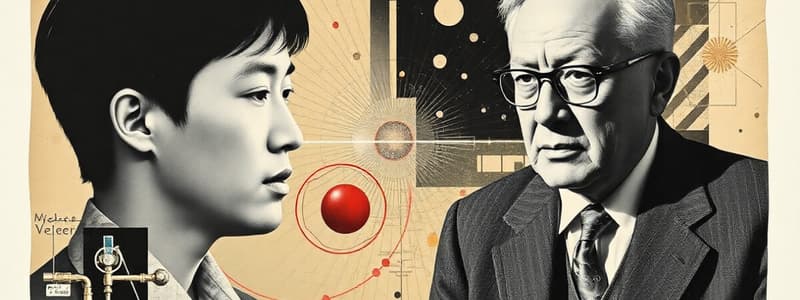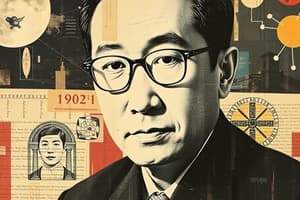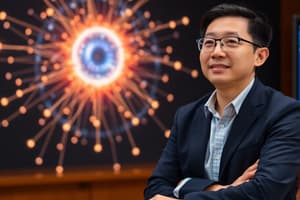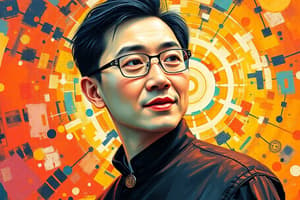Podcast
Questions and Answers
What significant theory did Yang Chen-Ning propose in collaboration with Robert Mills in 1954?
What significant theory did Yang Chen-Ning propose in collaboration with Robert Mills in 1954?
- Quantum Field Theory
- Yang-Mills Theory (correct)
- String Theory
- Theory of Relativity
Which event directly led to Yang Chen-Ning and Tsung-Dao Lee being awarded the Nobel Prize in 1957?
Which event directly led to Yang Chen-Ning and Tsung-Dao Lee being awarded the Nobel Prize in 1957?
- Success of Chien-Shiung Wu's experiment (correct)
- Developing the Yang-Mills theory
- Proving the conservation of parity was fallible
- Publication of a paper on nuclear physics
In which year did Yang Chen-Ning earn a PhD in nuclear physics?
In which year did Yang Chen-Ning earn a PhD in nuclear physics?
- 1949 (correct)
- 1946
- 1943
- 1954
What law did Yang Chen-Ning challenge through his research into particle interactions?
What law did Yang Chen-Ning challenge through his research into particle interactions?
Which milestone indicates Yang Chen-Ning's appointment to a directorial position in physics?
Which milestone indicates Yang Chen-Ning's appointment to a directorial position in physics?
What year did Richard Feynman begin his role as a junior physicist at the Manhattan Project?
What year did Richard Feynman begin his role as a junior physicist at the Manhattan Project?
In which year did Feynman receive the Albert Einstein Award?
In which year did Feynman receive the Albert Einstein Award?
Which institution did Feynman attend for his Ph.D.?
Which institution did Feynman attend for his Ph.D.?
What notable field did Feynman engage in that involves the study of interactions between electrically charged particles?
What notable field did Feynman engage in that involves the study of interactions between electrically charged particles?
How did Feynman demonstrate his mathematical talent in his early life?
How did Feynman demonstrate his mathematical talent in his early life?
What did Feynman achieve on the Princeton graduate entrance exams in 1939?
What did Feynman achieve on the Princeton graduate entrance exams in 1939?
Which university did Feynman join as a professor of theoretical physics in 1950?
Which university did Feynman join as a professor of theoretical physics in 1950?
What major concern motivated Feynman to participate in the Manhattan Project?
What major concern motivated Feynman to participate in the Manhattan Project?
What did Benoît Mandelbrot contribute to the field of mathematics?
What did Benoît Mandelbrot contribute to the field of mathematics?
Which year did Mandelbrot coin the term 'fractal'?
Which year did Mandelbrot coin the term 'fractal'?
In which area can fractal geometry NOT be applied?
In which area can fractal geometry NOT be applied?
What notable award did Mandelbrot receive in 1993?
What notable award did Mandelbrot receive in 1993?
The Mandelbrot set is primarily associated with which mathematical concept?
The Mandelbrot set is primarily associated with which mathematical concept?
What key concept did Henry Stommel explain in his groundbreaking 1948 paper?
What key concept did Henry Stommel explain in his groundbreaking 1948 paper?
Which research station did Stommel establish to gather ocean data?
Which research station did Stommel establish to gather ocean data?
What was the primary focus of Stommel's book 'The Gulf Stream' published in 1958?
What was the primary focus of Stommel's book 'The Gulf Stream' published in 1958?
What effect primarily influences deep-ocean circulation according to Stommel?
What effect primarily influences deep-ocean circulation according to Stommel?
Stommel was awarded the National Medal of Science in which year?
Stommel was awarded the National Medal of Science in which year?
Which of the following statements about the 'Great Ocean Conveyor Belt' is true?
Which of the following statements about the 'Great Ocean Conveyor Belt' is true?
Before focusing on oceanography, what field did Stommel study?
Before focusing on oceanography, what field did Stommel study?
What concept did Stommel incorporate into his theory of global ocean circulation?
What concept did Stommel incorporate into his theory of global ocean circulation?
What was one of the significant impacts of Feynman diagrams in quantum electrodynamics (QED)?
What was one of the significant impacts of Feynman diagrams in quantum electrodynamics (QED)?
Murray Gell-Mann proposed a model in 1964 that categorized particles into which two main groups?
Murray Gell-Mann proposed a model in 1964 that categorized particles into which two main groups?
Which aspect of Feynman diagrams allows for the representation of particle behavior in quantum mechanics?
Which aspect of Feynman diagrams allows for the representation of particle behavior in quantum mechanics?
In which area did Feynman NOT make a significant contribution?
In which area did Feynman NOT make a significant contribution?
What is a defining characteristic of fermions and bosons as proposed by Murray Gell-Mann?
What is a defining characteristic of fermions and bosons as proposed by Murray Gell-Mann?
Why are Feynman diagrams considered helpful in textbooks and lectures?
Why are Feynman diagrams considered helpful in textbooks and lectures?
What type of interactions do Feynman diagrams primarily represent?
What type of interactions do Feynman diagrams primarily represent?
Which achievement is NOT associated with Richard Feynman?
Which achievement is NOT associated with Richard Feynman?
What year did Ernest McCulloch qualify as a doctor?
What year did Ernest McCulloch qualify as a doctor?
Which institution did McCulloch primarily conduct his research?
Which institution did McCulloch primarily conduct his research?
What was one of the main focuses of McCulloch's research in the 1970s?
What was one of the main focuses of McCulloch's research in the 1970s?
Who did McCulloch collaborate with on advancing stem cell research?
Who did McCulloch collaborate with on advancing stem cell research?
In which year was McCulloch inducted into the Canadian Science and Engineering Hall of Fame?
In which year was McCulloch inducted into the Canadian Science and Engineering Hall of Fame?
What was a major contribution of James Till in the field of stem cell research?
What was a major contribution of James Till in the field of stem cell research?
Which prestigious award did James Till receive in 2005 for his work in medical research?
Which prestigious award did James Till receive in 2005 for his work in medical research?
Where did James Till earn his PhD degree?
Where did James Till earn his PhD degree?
In which year did James Till and Ernest McCulloch publish their seminal paper on radiation sensitivity?
In which year did James Till and Ernest McCulloch publish their seminal paper on radiation sensitivity?
Which research topics did Till expand into later in his career?
Which research topics did Till expand into later in his career?
What was the primary purpose of McCulloch and Till's experiment involving irradiated mice?
What was the primary purpose of McCulloch and Till's experiment involving irradiated mice?
What significant finding did McCulloch and Till publish about the colonies observed in the spleens of irradiated mice?
What significant finding did McCulloch and Till publish about the colonies observed in the spleens of irradiated mice?
Which type of cells were identified as the 'colony-forming units' in McCulloch and Till's research?
Which type of cells were identified as the 'colony-forming units' in McCulloch and Till's research?
How did McCulloch and Till enhance their understanding of the lineage of the cells in their experiment?
How did McCulloch and Till enhance their understanding of the lineage of the cells in their experiment?
What was the impact of McCulloch and Till's work after their findings were initially published?
What was the impact of McCulloch and Till's work after their findings were initially published?
Flashcards
Who was Richard Feynman?
Who was Richard Feynman?
Richard Feynman was a renowned physicist who made complex subjects like quantum theory accessible and entertaining. His work significantly impacted physics and technology.
What was Feynman's contribution to the Manhattan Project?
What was Feynman's contribution to the Manhattan Project?
Feynman worked as a junior physicist on the Manhattan Project, contributing to the development of the atomic bomb during World War II.
Where did Feynman teach theoretical physics?
Where did Feynman teach theoretical physics?
Feynman became a professor of theoretical physics at the California Institute of Technology (Caltech) in 1950, a significant milestone in his career.
What are the famous lectures Feynman delivered?
What are the famous lectures Feynman delivered?
Signup and view all the flashcards
Why did Feynman win the Nobel Prize in Physics?
Why did Feynman win the Nobel Prize in Physics?
Signup and view all the flashcards
What was Feynman like as a child?
What was Feynman like as a child?
Signup and view all the flashcards
Where did Feynman receive his education?
Where did Feynman receive his education?
Signup and view all the flashcards
What was Feynman's legacy?
What was Feynman's legacy?
Signup and view all the flashcards
Coriolis Effect
Coriolis Effect
Signup and view all the flashcards
Fluid Dynamics
Fluid Dynamics
Signup and view all the flashcards
Gulf Stream
Gulf Stream
Signup and view all the flashcards
Seawater Sampling
Seawater Sampling
Signup and view all the flashcards
Thermohaline Circulation
Thermohaline Circulation
Signup and view all the flashcards
Great Ocean Conveyor Belt
Great Ocean Conveyor Belt
Signup and view all the flashcards
Stommel's 1948 Paper
Stommel's 1948 Paper
Signup and view all the flashcards
The Gulf Stream (Book)
The Gulf Stream (Book)
Signup and view all the flashcards
Feynman Diagrams
Feynman Diagrams
Signup and view all the flashcards
Fermions
Fermions
Signup and view all the flashcards
Bosons
Bosons
Signup and view all the flashcards
Quantum Electrodynamics (QED)
Quantum Electrodynamics (QED)
Signup and view all the flashcards
The Standard Model of Particle Physics
The Standard Model of Particle Physics
Signup and view all the flashcards
Quark model
Quark model
Signup and view all the flashcards
Murray Gell-Mann
Murray Gell-Mann
Signup and view all the flashcards
Richard Feynman
Richard Feynman
Signup and view all the flashcards
Conservation of Parity
Conservation of Parity
Signup and view all the flashcards
Weak Interaction
Weak Interaction
Signup and view all the flashcards
Yang's Groundbreaking Research
Yang's Groundbreaking Research
Signup and view all the flashcards
Nobel Prize for Physics
Nobel Prize for Physics
Signup and view all the flashcards
Yang-Mills Theory
Yang-Mills Theory
Signup and view all the flashcards
Fractal Geometry
Fractal Geometry
Signup and view all the flashcards
Benoît Mandelbrot
Benoît Mandelbrot
Signup and view all the flashcards
Mandelbrot Set
Mandelbrot Set
Signup and view all the flashcards
Data Analysis with Fractals
Data Analysis with Fractals
Signup and view all the flashcards
Applications of Fractal Geometry
Applications of Fractal Geometry
Signup and view all the flashcards
Who is Ernest McCulloch?
Who is Ernest McCulloch?
Signup and view all the flashcards
What was McCulloch's area of research?
What was McCulloch's area of research?
Signup and view all the flashcards
What was McCulloch's key scientific contribution?
What was McCulloch's key scientific contribution?
Signup and view all the flashcards
How was McCulloch's work recognized?
How was McCulloch's work recognized?
Signup and view all the flashcards
What is the impact of McCulloch's research?
What is the impact of McCulloch's research?
Signup and view all the flashcards
What was James Till's major research discovery?
What was James Till's major research discovery?
Signup and view all the flashcards
What was the main subject of Till and McCulloch's research?
What was the main subject of Till and McCulloch's research?
Signup and view all the flashcards
What were some of Till's later research interests?
What were some of Till's later research interests?
Signup and view all the flashcards
What is the significance of Till's research on stem cells?
What is the significance of Till's research on stem cells?
Signup and view all the flashcards
Who did James Till collaborate with for his stem cell research?
Who did James Till collaborate with for his stem cell research?
Signup and view all the flashcards
What is a stem cell?
What is a stem cell?
Signup and view all the flashcards
Why is the self-renewal of stem cells important?
Why is the self-renewal of stem cells important?
Signup and view all the flashcards
How did McCulloch and Till discover stem cells?
How did McCulloch and Till discover stem cells?
Signup and view all the flashcards
What did McCulloch and Till find about the nodules in mice spleens?
What did McCulloch and Till find about the nodules in mice spleens?
Signup and view all the flashcards
What are the medical implications of McCulloch and Till's discovery?
What are the medical implications of McCulloch and Till's discovery?
Signup and view all the flashcards





